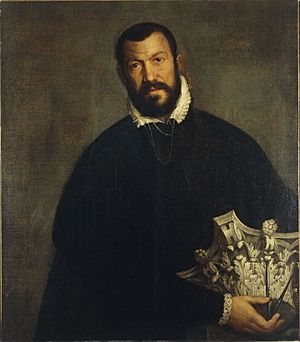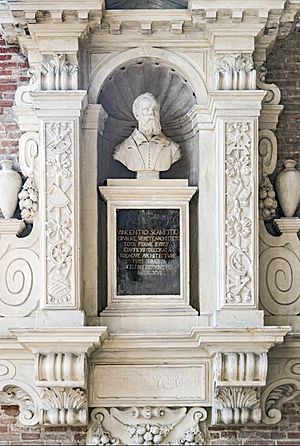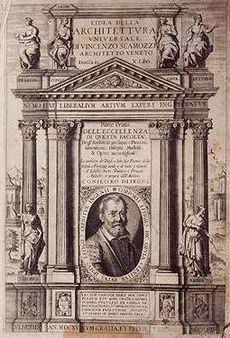Vincenzo Scamozzi facts for kids
Quick facts for kids
Vincenzo Scamozzi
|
|
|---|---|

Portrait of Vincenzo Scamozzi by Paolo Veronese
|
|
| Born | September 2, 1548 Vicenza, Italy
|
| Died | August 7, 1616 (aged 67) |
| Nationality | Italian |
| Occupation | Architect |
| Buildings | Palazzo Thiene Bonin Longare, Rocca Pisana, Villa Capra "La Rotonda", Villa Duodo, Palazzo Loredan Vendramin Calergi |
Vincenzo Scamozzi (born September 2, 1548 – died August 7, 1616) was a famous Italian architect. He also wrote books about architecture. Scamozzi worked mostly in the city of Vicenza and the area around Venice during the late 1500s.
He was a very important architect. He took over projects from Andrea Palladio, another great architect, when Palladio died in 1580. Scamozzi also taught Baldassarre Longhena, who became his only student. One big project he finished was the Teatro Olimpico in Vicenza. Palladio had designed this theater just before he passed away.
Contents
Biography of Vincenzo Scamozzi
Vincenzo Scamozzi was born in Vicenza, Italy. His father, Gian Domenico Scamozzi, was a surveyor and builder. He was Vincenzo's first teacher. His father taught him important ideas from the architect Sebastiano Serlio.
Vincenzo traveled to Rome in 1579 and 1580. Then, he moved to Venice in 1581. In 1600, he visited France. He kept a sketchbook of his thoughts on French buildings. This book was later published in 1959. Scamozzi is well-known for finishing many projects that Andrea Palladio left incomplete when he died in 1580.
Scamozzi's Book: Universal Architecture
Scamozzi's ideas spread far beyond Italy because of his two-volume book. It was called L'idea dell'architettura universale, which means "The Idea of a Universal Architecture." This book is one of the last important works from the Renaissance about how buildings should be designed.
It was first printed in Venice in 1615. The book included many of Scamozzi's own building plans and drawings. He showed how buildings were made, how they should have been made, and his ideal designs. This helped other architects learn from his work.
Designing Piazza San Marco
Scamozzi moved to Venice in 1581. He was asked to design the Procuratie Nuove in Piazza San Marco. This building was a row of official homes for the leaders of San Marco. It looked like a grand palace.
Scamozzi's design continued the style of the nearby Sansovino Library. It had arches on the ground floor and arched windows on the first floor. He added an upper floor to create more space. Scamozzi's work on the Procuratie Nuove was later continued by his student, Baldassare Longhena.
Major Works by Scamozzi
Most of Scamozzi's buildings are in the area of the Republic of Venice. Here are some of his important projects:
- 1572-1593: Palazzo Thiene Bonin Longare, Vicenza (he finished a design started by Palladio)
- 1575-1578: Rocca Pisana (Vettor Pisani Villa), Lonigo (Vicenza)
- 1580-1592: Villa Capra "La Rotonda", near Vicenza (he completed Palladio's famous villa)
- 1581-1599: Procuratie Nuove, Piazza San Marco, Venice (a large building in the main square)
- 1582-1591: Library of San Marco, Venice (he finished the library designed by Jacopo Sansovino)
- 1584-1585: Teatro Olimpico, Vicenza (he finished the theater designed by Palladio)
- 1588-1590: Teatro all'antica for Duke Vespasiano I Gonzaga, Sabbioneta (Mantova)
- 1591-1593: Design of Palmanova, an 'ideal city' built over 30 years
- 1591-1597: Villa Duodo and Chapel of San Giorgio, Monselice (Padua)
- 1596: Villa Ferretti, Sambruson del Dolo (Venice)
- 1597: Villa Molin, Mandria, (Padua)
- 1604-1612: Cathedral of Sts. Rupert and Virgil, Salzburg, Austria (he designed it, others finished it)
- 1607-1611: San Giorgio Maggiore (church), Venice (he finished the front of the church)
- 1609-1616: Palazzo Contarini degli Scrigni, Venice
- 1614: Palazzo Loredan Vendramin Calergi, Venice (east wing)
Images for kids
-
Villa Molin at Mandria, south of Padua.
See also
 In Spanish: Vincenzo Scamozzi para niños
In Spanish: Vincenzo Scamozzi para niños




